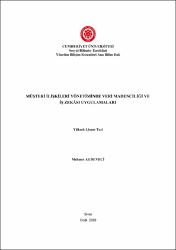| dc.contributor.advisor | Kaynar, Oğuz | |
| dc.contributor.author | Deveci, Mehmet Ali | |
| dc.date.accessioned | 2022-04-28T08:53:11Z | |
| dc.date.available | 2022-04-28T08:53:11Z | |
| dc.date.issued | 2018 | tr |
| dc.date.submitted | 2017-12-27 | |
| dc.identifier.other | XIV, 95 sayfa | |
| dc.identifier.uri | https://hdl.handle.net/20.500.12418/12497 | |
| dc.description.abstract | Günümüzde küreselleşmenin de etkisiyle artan rekabet işletmeler için müşterilerin ihtiyaç, talep ve beklentilerini yakından takip ederek en uygun ve en hızlı şekilde cevap verme zorunluluğu doğurmuştur. Müşteri taleplerinin öneminin artması ve işletmelerin bu talepleri takip ederek gerekli şekilde karşılık verme zorunluluğu müşteri ilişkileri yönetimi kavramını ortaya çıkarmıştır. Müşteri ilişkileri yönetimi, müşterilerle karşılıklı faydaya dayanan ilişkiler geliştirerek müşteri sadakatini kazanmayı ve bu sayede işletmeye uzun vadeli fayda sağlamayı amaçlayan bir yaklaşımdır. Bu yaklaşımın başarısı işletmenin müşteriyi doğru şekilde tanımasına bağlı olarak artmaktadır. Bu nedenle müşterilerle etkili şekilde iletişim kurmayı amaçlayan müşteri ilişkileri yönetimi uzmanları müşterilere ait her türlü bilgiye önem vermektedir. İşletmeler, teknolojinin de yardımıyla farklı kaynaklardan topladıkları verileri çeşitli veri madenciliği yöntemleriyle inceleyerek müşterilere ait daha geçerli bilgiler elde edebilmekte ve bu sayede müşterilerle daha etkili bir iletişim geliştirebilmektedir.
Bu tez çalışmasında ilk olarak bir e-ticaret sitesinden alışveriş yapan müşterilerin alışveriş kalıpları belirlenmeye ve bu kalıplara uygun pazarlama stratejileri önerilmeye çalışılmıştır. Bu amaçla müşteriler alışveriş sıklıkları, son alışveriş tarihleri ve incelenen dönem içerisindeki harcama meblağları bakımından ÖÖA ve K-means algoritmaları kullanarak 8 gruba ayrılmıştır. Oluşturulan bu 8 müşteri grubunda ÖÖA algoritması sonucunda 3, K-means algoritması sonucunda ise 4 farklı davranış modeli ortaya çıkmıştır. Çalışmada ikinci olarak bir telekomünikasyon şirketine ait müşteri verileri üzerinde yapay sinir ağları, naive-bayes, destek vektör makineleri ve lineer regresyon kullanılarak müşteri ayrılma analizi yapılmış ve söz konusu algoritmaların bu analiz için etkinliği belirlenmeye çalışılmıştır. Bu analiz için kullanılan veri seti 4667 müşteriden ve her müşteri için 19 adet işlem kaydına ait özellikler ile müşterinin terk edip terk etmediğine dair sınıf etiketlerinden oluşmaktadır. Ayrıca söz konusu özelliklerin sınıflamaya olan etkilerinin sıralanması için ki-kare, bilgi kazancı, kazanım oranı ve Relief-F olmak üzere 4 farklı metrik aynı veri seti üzerine uygulanmıştır. | tr |
| dc.description.abstract | At the present time, increasing competition due to influence of globalization has caused the obligation of responding to the needs, demands and expectations of the customers for the enterprises in the most appropriate and fastest way. Increasing of importance of customer requests and the obligation of enterprises to respond to these requests in the necessary manner reveals the concept of customer relationship management. Customer relationship management is an approach that aims to acquire customer loyalty by developing mutually beneficial relationships with customers and to provide long-term benefits to company. The success of this approach is increase depend on the ability of company to properly define customer‟s needs, characteristic and demands. For this reason, customer relationship management specialists who aim to communicate effectively with customers give importance to every kind of information belonging to customers. With the help of technology, company can obtain more valid information from customers by examining the data which collect from various sources through various data mining methods and can develop more effective communication with customers.
In this thesis, firstly, it was tried to determine the shopping patterns of the customers who shop at an e-commerce site and to suggest marketing strategies that are appropriate for the customers who included in these shopping patterns. For this purpose, customers are divided into 8 groups in terms of shopping frequency, last shopping dates and expenditure amounts in the period examined by using the self-organizing maps and K-means algorithms. In the 8 groups of customers that have been created, 3 different patterns of behavior have emerged as the result of the self-organizing maps algorithm and 4 different behavior models emerged as the result of the K-means algorithm. In the study, secondly, customer churn analysis was performed using artificial neural networks, naive-bays, support vector machines and linear regression on customer data of a telecommunication company and it has been tried to determine the effectiveness of these algorithms for this analysis. The data set used for this analysis consists of 4667 customers, 19 transaction record features for each customer and class labels indicating that the customer has churn or not-churn. In addition, four different metrics were applied to the same dataset: chi-square,information gain, recovery rate and Relief-F for ordering the effects of classification of the features. | tr |
| dc.language.iso | tur | tr |
| dc.publisher | Sivas Cumhuriyet Üniversitesi - Sosyal Bilimler Enstitüsü | tr |
| dc.rights | info:eu-repo/semantics/openAccess | tr |
| dc.subject | RFM Analizi | tr |
| dc.subject | Müşteri Ayrılma Analizi | tr |
| dc.subject | Müşteri İlişkileri Yönetimi | tr |
| dc.title | Müşteri İlişkileri Yönetiminde Veri Madenciliği ve İş Zekâsı Uygulamaları | tr |
| dc.type | masterThesis | tr |
| dc.contributor.department | Sosyal Bilimler Enstitüsü | tr |
| dc.relation.publicationcategory | Tez | tr |















